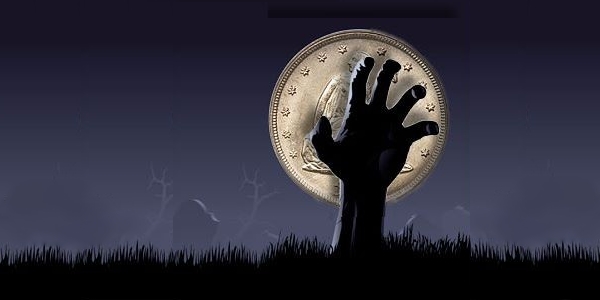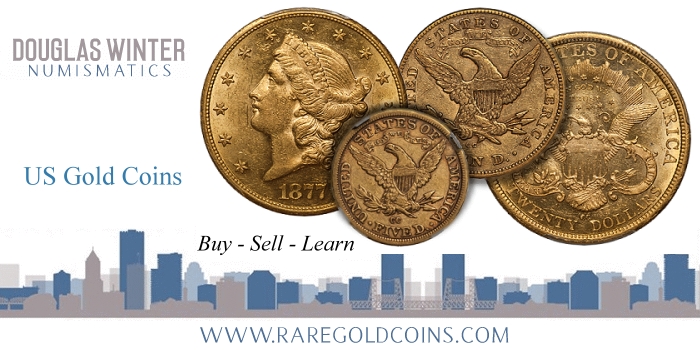Ways to Improve Your Coin Collection by Doug Winter – RareGoldcoins.com
CoinWeek Content Partner ……
Someone recently asked me a question that I thought was interesting and that merited a detailed response. To paraphrase this question, they basically asked me this: can you tell me some ways that I can improve my coin collection while spending little or no money?
Are there any actual ways that you can make your coin collection better without dropping a lot of coin (bad pun intended)? I believe that there are and here are a few that came to mind:

1. Bring Out Your Dead. Every collector has them. Duds. Bad deals. Low-end duplicates. You know what I’m talking about: the Dead Zone of your coin collection. These coins may represent more value than you realize. As an example, I recently had a relatively expensive double eagle in stock that a collector wanted for his set but he had no extra money at the time. I had him send me a list of the dead coins he owned; bullion, generic Saints, Morgan dollar rolls, etc. The value of his “stuff” was considerably more than he realized and he was actually in a nice profit position on his bullion. The choice to trade spillage for one nice, rare coin was easy for him to make. And the good news was that he had enough money left over so that he can actively pursue another neat coin or two.
2. Attribute Your Coins. If you collect series like Bust half dollars or large cents you are probably already a die variety collector and all of your coins are properly attributed. But what if you are a collector of early half eagles and you have never bothered to attribute your coins to Bass-Dannreuther variety numbers? And what if one of your supposedly common half eagles turns out to be a very rare die variety that is worth a 30-50% premium? Seems like a no-brainer to me. Even if you collect a series for which there is no standard reference work, it makes sense to examine your coins with a 10x glass and see if anything interesting is happening. Who knows, maybe you’ll discover a previously unknown mispunched date or a cool double date that has not been recorded.
3. Invest $500 to $1000 in improving your library. If you collect early gold coins you probably own the Bass Dannreuther book and a few other standard references. But do you own pertinent auction catalogs? It has long been my belief that one of the best uses of your money is a good library. You’ll get more enjoyment out of your coin collection if you know more about them and there is no better way to learn about a series, especially one that is somewhat obscure, than reading books and catalogs. If you don’t know which books or catalogs to pursue, ask a specialist dealer which ones he refers to or, better yet, contact a numismatic literature dealer and ask for some suggestions.
4. Improve your peripherals. If you are using an old, slow computer you are missing out on the “full experience” when it comes to coins. Not everyone has the luxury of owning a sporty, brand-new computer but with the price of monitors having dropped so considerably in the last few years treat yourself to a 16 inch or 18 inch flat screen monitor. It’s just a few hundred bucks and it sure beats viewing coin images on an old, low resolution screen. Spend some money on a good quality new magnifying glass and a high-quality lamp to view your coin collection as well. You’re looking at $50-100 for a world-class loupe and around $100-150 for a professional quality halogen coin lamp.
5. Research the pedigrees of your coins. This area is not relevant if you a collect fairly common series. If you are working on a set of business strike Indian Head quarter eagles in MS60 to MS62, it will be virtually impossible to determine the pedigree of these coins. But if you specialize in an area like Dahlonega quarter eagles or Fat Head half eagles, it is quite possible that some of the coins in your collection come from famous collections. Not everyone reading this will agree with me, but I believe that the “right” pedigree adds value and collectability to a coin collection and to discover that your 1847-D quarter eagle is from the Norweb collection or the Green Pond sale is pretty darn exciting. And if you collect Colonials or early cents, there is a possibility that a coin you own could have a pedigree that goes back over 100 years.
6. Start a cheap secondary coin collection. I’ve mentioned before that there is nothing more frustrating than being a collector who is either cash-strapped or at a point in his collection where there are no easily available holes to fill. In a scenario such as this, I always recommend having a cheap but interesting secondary collection to fulfill your “need” to buy something and to keep out of trouble. How about 18th century British Condor tokens? They are fascinating, well-designed and you can buy lovely examples for less than $100. Start a “one country one coin” collection where you purchase one coin from every country that currently makes coins. Or, focus on a certain year (say 1899), figure out every country that existed at the time, and buy one copper or silver coin from each of these nations.
7. Immortalize your collection. Let’s say you’ve worked on a neat specialized collection for a number of years but you are currently “out of gas” due to finances or unavailability of stopper dates in the series. Why not create a website that focuses on your coins and/or the series you collect. As an example, say that you are working on a set of No Motto Liberty Head eagles. There’s never been a book that has specifically focused on these coins; just works such as my New Orleans reference that has included them as specific issues within a larger context. You could buy the URL nomottoeagles.com and create a research site that lists the finest known pieces, varieties for each year, auction records, etc and which had photos of each of your coins. I have seen this done for a few specific types (as an example, a collector has done this for Trade and Seated Dollars and the results are extremely impressive). Doing this is a win-win for everyone involved. It gets people more interested in the series you already collect and it gets potential buyers more interested in your coins when you are ready to sell. Plus, it seems like a fun thing to do in your free time.
* * *
About Doug Winter
 Doug has spent much of his life in the field of numismatics; beginning collecting coins at the age of seven, and by the time he was 10 years old, buying and selling coins at conventions in the New York City area.
Doug has spent much of his life in the field of numismatics; beginning collecting coins at the age of seven, and by the time he was 10 years old, buying and selling coins at conventions in the New York City area.
In 1989, he founded Douglas Winter Numismatics, and his firm specializes in buying and selling choice and rare US Gold coins, especially US gold coins and all branch mint material.
Recognized as one of the leading specialized numismatic firms, Doug is an award-winning author of over a dozen numismatic books and the recognized expert on US Gold. His knowledge and an exceptional eye for properly graded and original coins have made him one of the most respected figures in the numismatic community and a sought-after dealer by collectors and investors looking for professional personalized service, a select inventory of impeccable quality, and fair and honest pricing. Doug is also a major buyer of all US coins and is always looking to purchase collections both large and small. He can be reached at (214) 675-9897.
Doug has been a contributor to the Guidebook of United States Coins (also known as the “Redbook”) since 1983, Walter Breen’s Encyclopedia of United States and Colonial Coins, Q. David Bowers’ Encyclopedia of United States Silver Dollars and Andrew Pollock’s United States Pattern and Related Issues
In addition, he has authored 13 books on US Gold coins including:
- Gold Coins of the New Orleans Mint: 1839-1909
- Gold Coins of the Carson City Mint: 1870 – 1893
- Gold Coins of the Charlotte Mint: 1838-1861
- Gold Coins of the Dahlonega Mint 1838-1861
- The United States $3 Gold Pieces 1854-1889
- Carson City Gold Coinage 1870-1893: A Rarity and Condition Census Update
- An Insider’s Guide to Collecting Type One Double Eagles
- The Connoisseur’s Guide to United States Gold Coins
- A Collector’s Guide To Indian Head Quarter Eagles
- The Acadiana Collection of New Orleans Coinage
- Type Three Double Eagles, 1877-1907: A Numismatic History and Analysis
- Gold Coins of the Dahlonega Mint, 1838-1861: A Numismatic History and Analysis
- Type Two Double Eagles, 1866-1876: A Numismatic History and Analysis
Finally, Doug is a member of virtually every major numismatic organization, professional trade group and major coin association in the US.






MR. Winter
Another great article and one that many collectors need.
I love the suggestion of having a secondary, cheap collection to reign in one’s spending habits. Despite some series being viewed as too common to spend much time than on errors or buying silver proofs to bother with by some in the collecting community, I think these series are perfect for coin roll hunting. You can still find some nice toned AU and MS grade State and ATB Quarters in circulation. And once in a great while you might get a wonderful Mint State Washington clad Quarter only recently released into circulation (as I did with surprise when receiving in change a 1972 P Quarter that looked like it had just been taken out of its Mint packaging less than a week or two ag). This is especially true as over time it becomes harder and harder to find any of the old silver coinage from before 1965 in circulation. Plus, you save money buying Mint sets to procure these series which can be put toward money for a very nice one (think about it, buying say all Mint sets from 1971 – 2019 can easily run you over $500)
And thank you for the suggestion of the British Condor tokens — did not know of these. I was told recently about the Maundy money sets which are sold as sets or individual coins – another area one could pursue affordably if they get individual coins (sets can start to get costly for those on a modest budget, especially ultra-modern issues as well as those from centuries ago). But those Condor tokens sound like a great affordable option too.
Thanks again for this article.